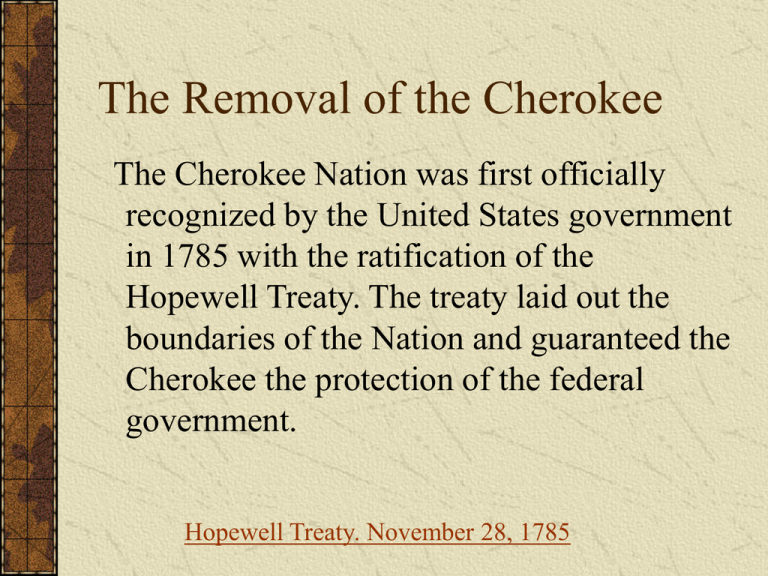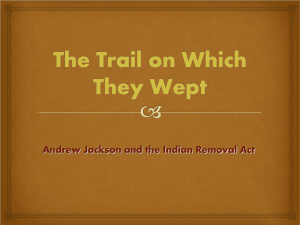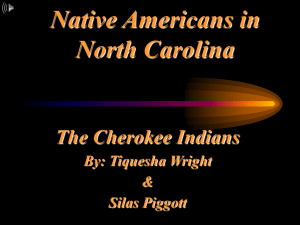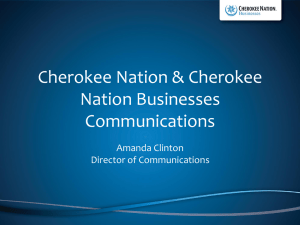Powerpoint on the Cherokee Removal with embedded lesson on
advertisement

The Removal of the Cherokee The Cherokee Nation was first officially recognized by the United States government in 1785 with the ratification of the Hopewell Treaty. The treaty laid out the boundaries of the Nation and guaranteed the Cherokee the protection of the federal government. Hopewell Treaty. November 28, 1785 The Cherokee Removal In 1802, President Thomas Jefferson signs an agreement with Georgia where Georgia gave up its claims for western territory in exchange for the federal government’s promise to eventually remove the Indians (mostly Cherokee & Creek) from Georgia as long as Georgia paid for the lands through peaceful treaty terms. The Cherokee Removal In an effort to stay within Georgia, many of the Cherokee attempted to assimilate American culture and religion. This meant learning “white ways”, the English language, converting to Christianity, and copying the type of government the United States had. Many of the Cherokee who were for assimilation were “mixed bloods” – Cherokees who had both Indian and European parents or ancestors. The Cherokee Removal Assimilation activity Write down a description of the candy in front of you. What does it look like, feel like, smell like? How is the candy different from you. Put the candy in your mouth but don’t eat it. Is it still candy? Go ahead an eat the candy. Now is it still candy? If it’s not candy anymore, what exactly is it? The Cherokee Removal What does assimilation mean? What happens to something when it becomes assimilated? What happens to a person if he or she becomes assimilated? What were the consequences to the Cherokee if they did not assimilate? What arguments do you think the Cherokee had amongst themselves about assimilation? Were the Cherokee Americans in the eyes of the US government and the state of Georgia? The Cherokee Removal Major John Ridge, a Cherokee chief, and his nephew, Elias Boudinot (co-founder of the Phoenix newspaper) were both in favor of assimilation. Elias Boudinot Major John Ridge The Cherokee Removal One of the features of assimilation meant that the Cherokee would have to adopt “white methods” of farming. In the South, this often meant plantations. The Cherokee increased the number of slaves they held and a few started living in the same manner as wealthy white planters. The Cherokee Removal James Vann, a Cherokee, owned about 200 slaves and hundreds of acres of farm ground The Cherokee Removal Only about 8% of the Cherokee owned slaves, most of the slave holders were “mixed-blood” About 17% of the Cherokee had some white ancestry. About 60% of the Cherokee households had at least one literate member. In 1821, the Cherokee had their own written language, the first tribe in the US to do so. The Cherokee Removal By 1828, the Cherokee denied citizenship rights to any blacks living in the nation. By 1822, the Cherokee had created a National Superior Court modeled after the US Supreme Court. By 1827, the Cherokee had created a Constitution, modeled after the US Constitution By 1835, less than 10% of the Cherokee had converted to Christianity. How assimilated had the Cherokee become? The Cherokee Removal Why did Georgians want the Cherokee lands? It was good fertile ground for farming. They did not want the Cherokee to have an independent nation within their borders Some of the Cherokee land was rich with gold. The first gold mines were opened in 1829. There were northern missionaries on the Cherokee lands who preached against slavery – a fact that greatly upset most Georgians. Why was it ok for Georgia to take Cherokee land from the Cherokee but not ok to take it from other people? The Cherokee Removal In 1828, Andrew Jackson was elected President. Although the Cherokee had helped Jackson win an important battle against Creek Indians in 1814, Jackson was determined to move the Cherokee to the Oklahoma Territory. In 1830, he got Congress to pass the Indian Removal Act. The Cherokee Removal In 1832, the Supreme Court ruled in Worcester vs. Georgia, that the state of Georgia could not enforce its laws on the Cherokee, only the federal government could. President Jackson chose to ignore the ruling and refused to provide federal protection for the Cherokee who were at the mercy of the Georgia Guard (army). The Cherokee Removal Also in 1832, Georgia decided to have a lottery for the Cherokee lands. The Cherokee lands were divided up into either 160 acres if no gold was thought to be on the land or 40 acres if gold was thought to be present. Georgians were then given the opportunity to draw a lottery ticket to see if they “won” Cherokee land. Georgia map before the lottery New Georgia counties created by the Cherokee lands Map after the lottery The Cherokee Removal In 1835, the US government proposed to buy the Cherokee lands in Georgia from the Cherokee for five million dollars. The majority of the Cherokee, led by Chief John Ross, wanted to stay and refused to sign the Treaty of New Echota. Major Ridge, his son John, and Elias Boudinot led a minority group that believed that signing the treaty and moving west was the only realistic choice. The Cherokee Removal Major Ridge, his son, Elias Boudinot and about two dozen other prominent Cherokee signed the treaty. When they did so they thought they were acting in the best interest of the nation. They also knew they were violating the Cherokee “blood law” which made selling land to whites, without majority support, a crime punishable by death. What do you think might have happened to Ridge, his son, and Boudinot? The Cherokee Removal John Ross presented a petition to the US government of 16,000 signatures (out of 17,000 that lived in the Nation) stating that they opposed both the treaty and removal. Major Ridge pointed out that almost all of the “signatures” were “Xs” and could have been faked. The Cherokee Removal In 1838 and 1839, the removal of the Cherokee along with other Southeastern Indians occurred. Approximately 17,000 Cherokee made the trip with at least 4,000 dying from exposure, disease, and starvation on the trip. The Trail of Tears Many Trails of Tears The Cherokee in the Oklahoma Territory Qualla Boundary – Present Day Cherokee, NC







